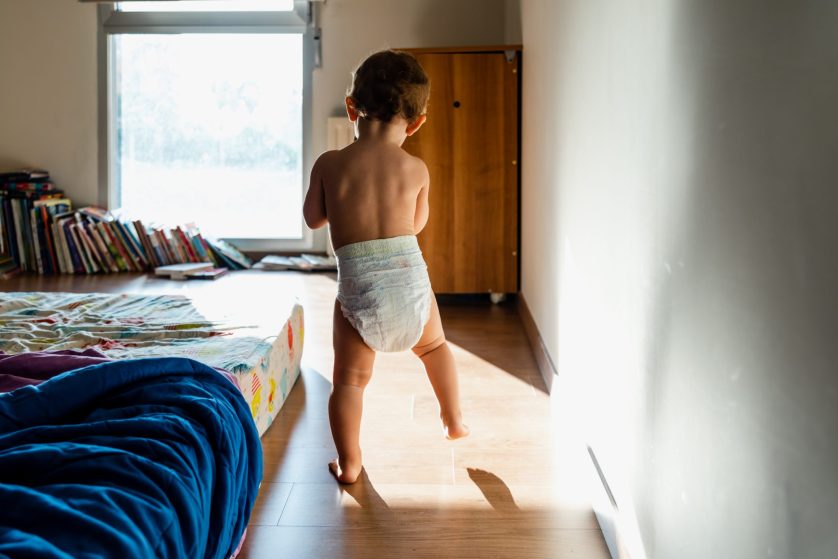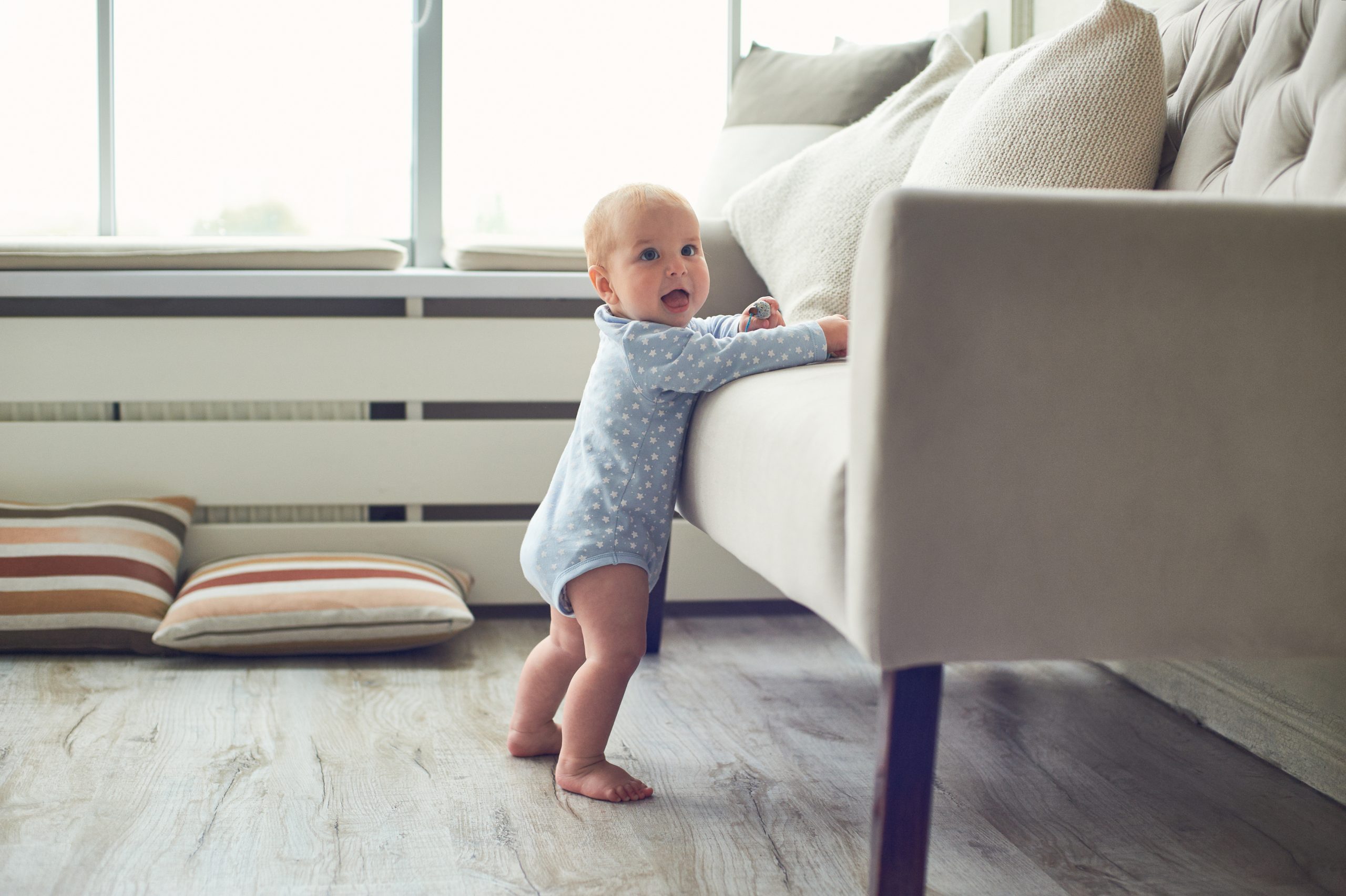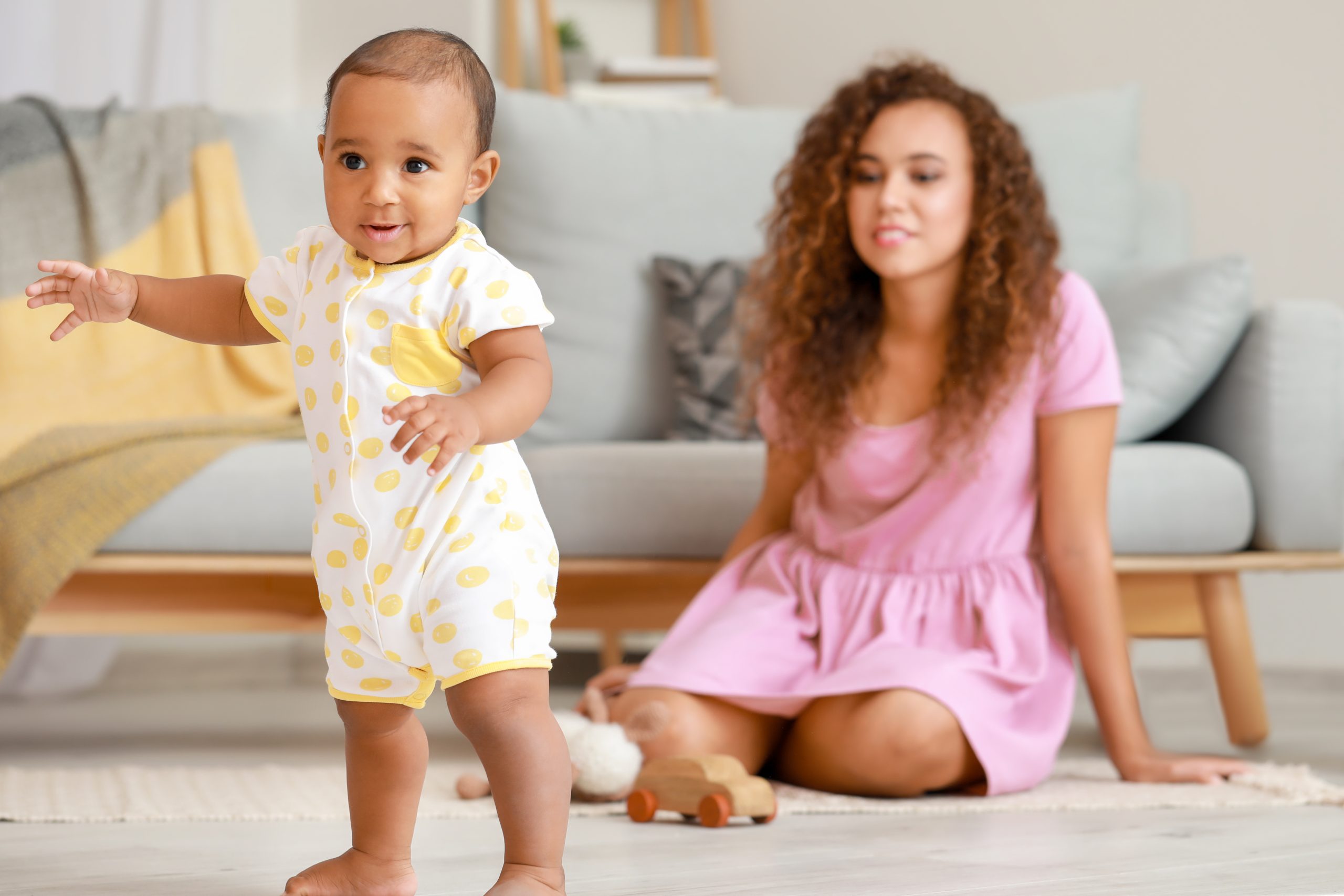8 Tips for Encouraging Your Baby’s First Steps

Watching your baby stand up and eventually take their first steps are some of the most exciting milestones for any parent. This is also an important time in a baby’s life, as it means your baby has coordinated nearly every major muscle group at once in order to stand up and walk. As your baby starts to stand, there are some ways you can encourage them to become more comfortable and confident as they start trying to walk. Here’s everything you need to know about your little one’s first steps.
When to Expect Standing
Babies can usually be expected to start standing with the help of objects from about 9 to 12 months. In order to stand up, they’ll use anything they can to help pull themselves and assist in the process. This could be the couch, the table or even your hands or legs.

If your baby hasn’t started standing after 12 months, this shouldn’t cause concern! Like all milestones in a baby’s life, there isn’t a set timeframe. Instead of worrying about your baby not standing yet, offer encouragement and support in the form of games or activities that will help strengthen your baby’s legs, hips and core and assist them in their journey to standing.
When to Expect Walking
Between the ages of 10 to 18 months, your baby may start walking. Before this though, there are usually signs of readiness to walk that your baby will display. This includes pulling themselves up using objects around the house, like we mentioned earlier, as well as cruising. Cruising is when your baby will use objects like couches to help balance while taking a couple of steps. The last thing that your baby will start doing before walking is standing unassisted.
Tips for Encouraging Independent Walking
Keep them barefoot
Babies rely on what they feel in order to guide them. Keeping your baby’s shoes off while they learn to walk is generally recommended by paediatric therapists. A baby’s learning process might be hindered if they cannot feel what they are walking on, as different surfaces require different uses of joints, muscles, and posture. Shoes themselves may also make it harder for them to learn, since they can restrict natural foot movement.
Encourage squatting
Getting your baby to squat down to pick things up can be a great way to expose your baby to different movements that will eventually help with standing and/or walking. Use a toy or something your baby will want to grab and place it at their feet. As they’re supported by a couch, they can squat down and pick up the item. This up and down motion will help build their hip and thigh muscles. They’ll also be learning how to shift their weight, which can help with coordination when it comes time to walk.
Use toys as motivation
Placing toys that you baby likes on top of raised surfaces, like couches, is a great way to motivate your baby to move and continue to walk and build their muscles. Make sure that the toys aren’t up too high and not too far away from your baby, as they can easily become tired when trying to walk too much. You can also place toys in a trail around the room and let them go from one to the next. Even if they crawl instead of trying to take a few steps to get to the next object, the motion is still helping to develop their gross motor skills they’ll need for walking.
Listen to music
When it comes to music, babies love it. They love to synchronise their movements to the sound of the music, especially by bouncing. As they bounce to the music, they’ll be developing their leg and core muscles, without actually walking.
Encourage exploring
Allowing your baby to explore wherever you are is a great way for them to experience different surfaces and heights. The more they can experience when they’re first learning, the easier it will be for them to become better at walking. So, allow walking to a different area of the house, or get them walking outside in order to experience more areas and raise their confidence.
Play with others
Babies learn best from watching then imitating. If your baby sees other babies standing up and walking, it might influence your baby to try and do the same. Arrange lots of playdates with other babies, and you may notice your baby will be pushing themselves to match the others!
Keep them supported
When your baby is walking by themselves for the first times, don’t make them go at it completely alone, too soon. Keep lots of support near them such as coffee tables, chairs, and stools that they can grab onto if they feel they need the support. Make sure you’re always around and ready to catch them, just in case they fall. The more times they see that they’re safe if they fall, the more comfortable and confident they’re going to feel walking.
Land them on their feet
When you go to put your baby down after holding them, start placing them on their feet, instead of in a sitting position. Although you may be used to placing your baby in a sitting position, you should start putting them on their feet to help build those muscles and have weight bearing on their feet. It also shows the expectation you have for them is to stand and walk.
Babyproofing Your Home

Babyproofing your home should be on all parents’ lists the moment their little one can start moving by themselves. From crawling to cruising to walking, the moment they can move, is the moment they can quickly enter areas of the house that may have some hazards. That’s why we have put together a list of things to think about when babyproofing your home.
- Baby gates: These are great for stopping your baby from being able to get into areas that aren’t babyproofed.
- Corners: Whether it’s wall corners or table corners, anything with a corner can become a danger. From tables at eye-level causing a head injury, lower corners causing an elbow or shin injury, there is no limit to how many things your baby could bang themselves on. Protective plastic guards are a great solution as they get rid of the sharpness of the corner.
- Outlets: Your baby is curious, so those white things with the switches at their eye level are going to intrigue them. Getting childproof outlet covers for your outlets will help keep them safe.
- Drawer locks: Things like cabinets and drawers should be locked, not only to stop your baby from pulling a drawer out onto themselves, but also to stop them from pulling the contents of the drawer onto the floor. This is especially important in the kitchen, where hazardous kitchen tools may be in a drawer or cabinet that they can reach, or in bathrooms, where you may store cleaning products in the lower cabinets.
- Door locks: Once your baby starts walking, they might be able to open doors, which can be dangerous if the rooms aren’t babyproofed and also can result in some jammed fingers. Having door locks allows them to still touch the door handle, but stops the baby from hurting themselves or getting inside when you may not want them to.
Conclusion
There is no set timetable when it comes to your baby learning how to stand, pull up, cruise or walk. Every baby is different and there is no need to rush these life milestones. Your job as a parent is to support what your baby is doing, instead of trying to rush it. We hope that with these tips on getting your little one to walk, your little one starts to develop the muscles and coordination they need for when they’re ready for their first steps.



